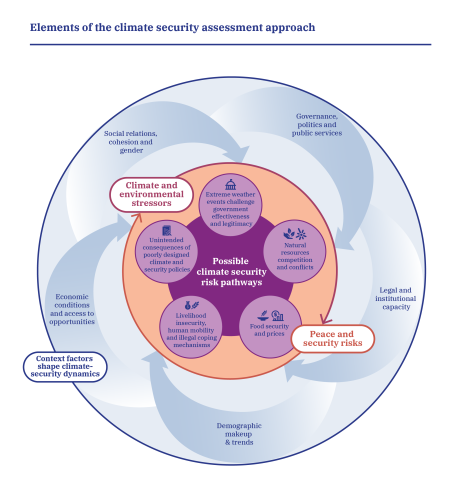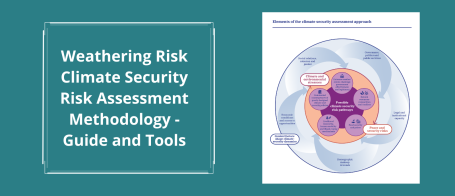Weathering Risk Climate Security Risk Assessment Methodology - Guide and Tools
Download the full assessment here.
Climate change reverses progress towards sustainable development and peace, posing risks to human security and making peace harder to achieve. Policy- and decision-makers in multiple sectors, especially development, diplomacy and defence, have sought ways to predict and respond to these impacts. However, in order to do so effectively and sustainably, the complexity of different factors and interactions has to be unpacked into a granular understanding of the relationship between environmental change and insecurity in a given context. For awareness of the risks to be converted into action that improves lives, concrete entry points need to be identified.
The first iteration of the Weathering Risk methodology consisted of five integrated steps to enable and guide adelphi's own risk assessments. However, not all of those steps were intended to be replicable. Based on two years of field testing through over twelve Weathering Risk assessments on the ground from the Pacific to the Levant, the original approach was adapted to make it easier, replicable and usable.
The approach was specifically developed to build upon existing analysis and work even when climate data availability is limited. While this methodology focusses on understanding and addressing localised climate security risks, it can be applied at different scales from the local to the regional and global. To this end, this document outlines a comprehensive climate-security assessment methodology. It combines state-of-the-art quantitative and qualitative methods in an innovative way.
Specifically, this assessment methodology integrates quantitative and qualitative methods to climate-security analysis; it includes high resolution climate impact data, conflict analysis and scenario methods; it is flexible in application in terms of geography and depth of analysis and it is forward-looking. Using this methodological approach, valuable resilience-building entry points can even be ascertained with limited, macro-level or patchy climate data.

Elements of the climate security assessment approach include:
- Climate and environmental stressors
Climate changes and their direct impacts, including temperature rise and its impacts on agriculture or flooding and its impact on infrastructure as well as other non-climate related environmental issues such as pollution.
- Peace and security risks
Peace and security context, which comprise the history and state of economic, social and political (in)stability, past and ongoing security risks and conflict dynamics, the drivers and causes of insecurity, and the main actors that have an impact on security and stability.
- Climate-security risk pathways
The interactions between climate impacts, security and peace or climate-security risk pathways that link certain climatic impacts with specific security risks and conflicts; for example, how more pressure on natural resources such as land and water can increase competition and tensions over access and availability of these resources and show how security risks and conflicts effect resilience, the environment and climate risks; for example, how insecurity can contribute to increased environmental degradation which in turn can undermine the resilience of local communities.
- Context factors, vulnerability and resilience
Context factors shaping vulnerability and resilience to climate and security risks, including a variety of cross-cutting topics like gender equality and social inclusion. These context factors normally play a decisive role in all pathways and should be at the centre of the analysis.
Selected tools, dashboards, variables, and indices to inform climate-security assessments are available as a separate download below.
Share on


